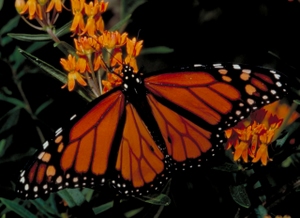Barrionuevo, Alexei 2007. Honeybees Vanish, Leaving Keepers in Peril. New York Times, February 27, Business Section. (Barrionuevo 2007)
Boyd, E.B. 2008. Earth for Hire. Conscious Choice, April. (Boyd 2007, 29)
Chicago Region Biodiversity Council, 1999. Biodiversity Recovery Plan. Chicago Region Biodiversity Council, Chicago, IL. (Chicago Region Biodiversity Council, 1999)
Chicago Wilderness. About Biodiversity: Threats to Local Biodiversity. http://www.chicagowilderness.org/biodiversity/threats/index.cfm. (Chicago Wilderness)
Chicago Wilderness. Green Infrastructure Vision Final Report. March 2004.
Green Infrastructure Vision Final Report (Chicago Wilderness, 2004)
Chicago Wilderness, "Table 2.3: Sum of Acres in Protected Natural Areas and in Other Significant Natural Areas by Community Type-1999", The State of Our Chicago Wilderness: A Report Card on the Health of the Region's Ecosystems, pages 12-18. (Chicago Wilderness, 1999)
Costanza, Robert, Ralph d'Arge, Rudolf de Groot, Stephen Farberk, Monica Grasso, Bruce Hannon, Karin Limburg, Shahid Naeem, Robert V. O'Neill, Jose Paruelo, Robert G. Raskin, Paul Suttonkk and Marjan van den Belt. 1997. The Value of the World's Ecosystem Services and Natural Capital. Nature 387, May 15. http://www.uvm.edu/giee/publications/Nature_Paper.pdf (accessed October 16, 2008). (Costanza et al. 1997, 387)
Covington, Wallace, Margaret M. Moore, William A. Niering and Joan L. Walker. "Adaptive Ecosystem Restoration and Management: Concepts and Principles." US Forest Service. http://www.fs.fed.us/eco/s10pre.htm (Covington et al.)
Crocker, S.J., Little, D.C., U.S. Forest Service, 2006 Illinois Forest Resources Report, http://nrs.fs.fed.us/pubs/2492 (Crocker and Little, 2006
Ecological Society of America (ESA). Ecosystem Services Fact Sheet. Ecological Society of America. http://www.esa.org/ecoservices/comm/body.comm.fact.ecos.html (ESA)
Forest Preserve District of Cook County. http://www.fpdcc.com/ (Forest Preserve District of Cook County)
Funder's Network for Smart Growth and Livable Communities, "Water and Smart Growth: The Impacts of Sprawl on Aquatic Ecosystems." Translation Paper No. 14, 2004. (Funder's Network 2004, 14)
Lake County Forest Preserve District. http://www.lcfpd.org/html_lc/referendum/main.html (Lake County Forest Preserve District)
Illinois Department of Natural Resources (IDNR), Critical Trends Assessment Program, http://www.dnr.state.il.us/orep/ctap/index.htm (IDNR)
Illinois Department of Natural Resources (IDNR). 1998. The upper Des Plaines River basin: An inventory of the region's resources. Illinois DRN, Springfield, IL. (IDNR, 1998)
Illinois Environmental Protection Agency (IEPA). Illinois Annual Air Quality Report 2006, Executive Summary, December 2007, www.epa.state.il.us/air/air-quality-report/2006/index.html (IEPA)
Illinois Natural History Survey(INHS). Institute of Natural Resource Sustainability (University of Illinois at Urbana-Champaign). Annual Report FY 2001 (July 2000 through June 2001). "Invasive/Exotic Species." http://www.inhs.uiuc.edu/resources/annualreports/00_01/inv-exot.html. (INHS, 2001)
Illinois State Geological Survey(ISGS). Home page. http://www.isgs.uiuc.edu/ (ISGS)
llinois State Museum Society. Museum Link Illinois, Prairie (ecosystems and restoration). Museum State Museum Society. http://www.museum.state.il.us/muslink/prairie/index.html (Illinois State Museum Society)
Lovett, Gary, Timothy Tear, "Threats from Above: Air Pollution Impacts on Ecosystems and Biological Diversity in the Eastern United States", The Nature Conservancy and the Cary Institute of Ecosystem Studies, June 2008, http://www.ecostudies.org/Threats_from_Above.pdf (Lovett and Tear, 2008)
MacCleery, Doug. "Aldo Leopold's Land Ethic: Is it Only Half a Loaf Unless a Consumption Ethic Accompanies It?" Eco-Watch, April 11, 1999. US Forest Service. (MacCleery, 1999)
MaFadden, Zena 2007. Colony collapse disorder is reducing U.S. bee population, and, no, it is not a good thing. Beyond Wisconsin, April 26, Medill News Service. http://www.journaltimes.com/nucleus/index.php?itemid=12512 (McFadden, 2007)
Midwestern Regional Climate Center, Midwest Weekly Highlights: September 10 – 16, Illinois http://mcc.sws.uiuc.edu/cliwatch/0809/080916.htm
Molano-Flores, Brenda, Steve Bailey, and Rhetta Jack, "Regional, Landscape, and Patch Size Differences: Do They Matter for Forest Bird Species Across Illinois?", Illinois Department of Natural Resources, Critical Trends Assessment Program 2003-2004, December 2004 http://www.dnr.state.il.us/orep/ctap/index.htm (Molano-Flores et al. 2003)
Native Languages of the Americas. Native American Tribes of Illinois. http://www.native-languages.org/illinois.htm (Native Languages of the Americas)
Northeastern Illinois Planning Commission (NIPC). 2004. Natural Landscaping For Local Officials: Design and Management Guidelines. (NIPC, 2004)
Openlands. Home page. www.openlands.org (Openlands)
Shore, Debra. 2005. Power and Plants. Chicago Wilderness Magazine, Summer. (Shore 2005)
Society for Ecological Restoration (SER) International Press Release and Position Paper. "A Global Strategy for Mitigating Climate Change." August 6, 2007. http://www.ser.org/pdf/ClimateChangePosition.pdf (SER, 2007)
Society for Ecological Restoration International Science & Policy Working Group. 2004. The SER International Primer on Ecological Restoration. www.ser.org & Tucson: Society for Ecological Restoration International (SERI). (SERI, 2004)
Snover, A.K, L. Whitely Binder, J. Lopez, E. Willmott, J. Kay, D. Howell, and J. Simmonds. 2007. Preparing for Climate Change: A guide book for Local, Regional, and State Governments. In association with and published by ICLEI – Local Governments for Sustainability, Oakland, CA. (Snover et al. 2007)
Sullivan, Jerry. An Atlas of Biodiversity. Chicago Wilderness 2003. (Sullivan, 2003)
Sullivan, Robert G. and Milt Clark. 2007. Can Biodiversity Survive Global Warming?. CW Journal Vol. 5 No. 1: 2-13. (Sullivan and Clark 2007, 2)
University of Aberdeen, UK. Biodiversity and Ecosystem Function: Introduction, http://www.abdn.ac.uk/ecosystem/bioecofunc/intro.htm (University of Aberdeen)
United States Environmental Protection Agency. Ecological Research Program. Updated May 2008. http://www.epa.gov/ord/erp/faq.htm. (USEPA, 2008)
United States Environmental Protection Agency. Green Acres website. http://www.epa.gov/greenacres/#Benefits
United States Environmental Protection Agency. Region 5 Great Lakes Ecosystems, "Human-Induced Stresses Impacting the Area", Executive Summary Ecologically Rich Areas - Critical Ecosystem Team, June 1999 Draft, http://www.epa.gov/ecopage/R5/era/index.html (USEPA, 1999)
U.S. Army Corps of Engineers Chicago District, Butler Lake (Sec 206) Project, Authority: Section 206, Water Resources Development Act 1996, as amended (Continuing Authority Program), http://www.lrc.usace.army.mil/projects/Butler_lake/index.html (US Army Corps of Engineers)
U.S. Department of Energy – Office of Fossil Energy, National Energy Technology Laboratory. Carbon Sequestration Newsletter. May, 2008 (DOE, 2008)
Wilhelm, Gerould. October 1996. "What is Ecological Restoration and Why is it Important?" Conservation Research Institute. (Wilhelm, 1996) http://www.cdfinc.com/CDF_Resources/Importance_of_Ecological_Restoration.pdf
U.S. Forest Service. Home page. http://www.fs.fed.us/ (US Forest Service)
World Institute for Conservation and Environment, "Primary Ecosystem Modifiers, Terrestrial Ecosystems" http://www.ecosystems.ws/terrestrial_classifiers.htm and "Aquatic Classifiers or Modifiers" http://www.ecosystems.ws/aquatic_classifiers.htm (World Institute)
World Wildlife Fund (WWF). Living Planet Report 2006. http://www.panda.org/news_facts/publications/living_planet_report/index.cfm
(WWF, 2006)
